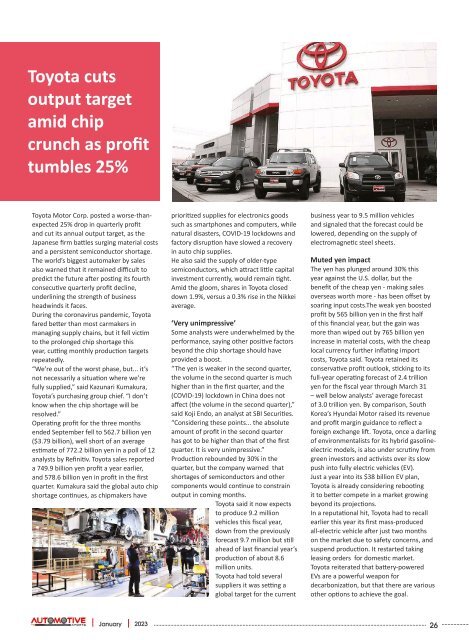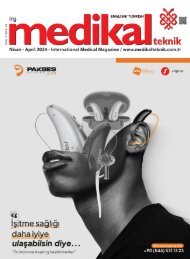You also want an ePaper? Increase the reach of your titles
YUMPU automatically turns print PDFs into web optimized ePapers that Google loves.
Toyota cuts<br />
output target<br />
amid chip<br />
crunch as profit<br />
tumbles 25%<br />
Toyota Motor Corp. posted a worse-thanexpected<br />
25% drop in quarterly profit<br />
and cut its annual output target, as the<br />
Japanese firm battles surging material costs<br />
and a persistent semiconductor shortage.<br />
The world’s biggest automaker by sales<br />
also warned that it remained difficult to<br />
predict the future after posting its fourth<br />
consecutive quarterly profit decline,<br />
underlining the strength of business<br />
headwinds it faces.<br />
During the coronavirus pandemic, Toyota<br />
fared better than most carmakers in<br />
managing supply chains, but it fell victim<br />
to the prolonged chip shortage this<br />
year, cutting monthly production targets<br />
repeatedly.<br />
“We’re out of the worst phase, but... it’s<br />
not necessarily a situation where we’re<br />
fully supplied,” said Kazunari Kumakura,<br />
Toyota’s purchasing group chief. “I don’t<br />
know when the chip shortage will be<br />
resolved.”<br />
Operating profit for the three months<br />
ended September fell to 562.7 billion yen<br />
($3.79 billion), well short of an average<br />
estimate of 772.2 billion yen in a poll of 12<br />
analysts by Refinitiv. Toyota sales reported<br />
a 749.9 billion yen profit a year earlier,<br />
and 578.6 billion yen in profit in the first<br />
quarter. Kumakura said the global auto chip<br />
shortage continues, as chipmakers have<br />
prioritized supplies for electronics goods<br />
such as smartphones and computers, while<br />
natural disasters, COVID-19 lockdowns and<br />
factory disruption have slowed a recovery<br />
in auto chip supplies.<br />
He also said the supply of older-type<br />
semiconductors, which attract little capital<br />
investment currently, would remain tight.<br />
Amid the gloom, shares in Toyota closed<br />
down 1.9%, versus a 0.3% rise in the Nikkei<br />
average.<br />
‘Very unimpressive’<br />
Some analysts were underwhelmed by the<br />
performance, saying other positive factors<br />
beyond the chip shortage should have<br />
provided a boost.<br />
“The yen is weaker in the second quarter,<br />
the volume in the second quarter is much<br />
higher than in the first quarter, and the<br />
(COVID-19) lockdown in China does not<br />
affect (the volume in the second quarter),”<br />
said Koji Endo, an analyst at SBI Securities.<br />
“Considering these points... the absolute<br />
amount of profit in the second quarter<br />
has got to be higher than that of the first<br />
quarter. It is very unimpressive.”<br />
Production rebounded by 30% in the<br />
quarter, but the company warned that<br />
shortages of semiconductors and other<br />
components would continue to constrain<br />
output in coming months.<br />
Toyota said it now expects<br />
to produce 9.2 million<br />
vehicles this fiscal year,<br />
down from the previously<br />
forecast 9.7 million but still<br />
ahead of last financial year’s<br />
production of about 8.6<br />
million units.<br />
Toyota had told several<br />
suppliers it was setting a<br />
global target for the current<br />
business year to 9.5 million vehicles<br />
and signaled that the forecast could be<br />
lowered, depending on the supply of<br />
electromagnetic steel sheets.<br />
Muted yen impact<br />
The yen has plunged around 30% this<br />
year against the U.S. dollar, but the<br />
benefit of the cheap yen - making sales<br />
overseas worth more - has been offset by<br />
soaring input costs.The weak yen boosted<br />
profit by 565 billion yen in the first half<br />
of this financial year, but the gain was<br />
more than wiped out by 765 billion yen<br />
increase in material costs, with the cheap<br />
local currency further inflating import<br />
costs, Toyota said. Toyota retained its<br />
conservative profit outlook, sticking to its<br />
full-year operating forecast of 2.4 trillion<br />
yen for the fiscal year through March 31<br />
– well below analysts’ average forecast<br />
of 3.0 trillion yen. By comparison, South<br />
Korea’s Hyundai Motor raised its revenue<br />
and profit margin guidance to reflect a<br />
foreign exchange lift. Toyota, once a darling<br />
of environmentalists for its hybrid gasolineelectric<br />
models, is also under scrutiny from<br />
green investors and activists over its slow<br />
push into fully electric vehicles (EV).<br />
Just a year into its $38 billion EV plan,<br />
Toyota is already considering rebooting<br />
it to better compete in a market growing<br />
beyond its projections.<br />
In a reputational hit, Toyota had to recall<br />
earlier this year its first mass-produced<br />
all-electric vehicle after just two months<br />
on the market due to safety concerns, and<br />
suspend production. It restarted taking<br />
leasing orders for domestic market.<br />
Toyota reiterated that battery-powered<br />
EVs are a powerful weapon for<br />
decarbonization, but that there are various<br />
other options to achieve the goal.<br />
<strong>January</strong> <strong>2023</strong> 26

















